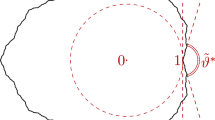Abstract
This paper considers a special class of continuous-time Markov chains of level-dependent M/G/1-type, where block matrices representing downward jumps in the infinitesimal generator are nonsingular. This special class naturally arises in the analysis of BMAP/M/\(\infty \) queues and BMAP/M/c queues with exponential impatience times (BMAP/M/c+M). We first formulate the boundary probability vector in terms of a solution of a system of infinitely many linear inequalities. We then reveal that in the above special class, this infinite system is regarded as a nested sequence of simplices, and we identify their vertices. Based on these results, we develop a simple yet efficient computational algorithm for the stationary distribution conditioned that the level is not greater than a predefined N. Note that for a large N, the conditional distribution will provide a good approximation to the stationary distribution. Some numerical examples for BMAP/M/\(\infty \) and BMAP/M/c+M queues are shown.








Similar content being viewed by others
References
Baumann, H., Sandmann, W.: Numerical solution of level dependent quasi-birth-and-death processes. Procedia Comput. Sci. 1, 1561–1569 (2012)
Bright, L., Taylor, P.G.: Calculating the equilibrium distribution in level-dependent quasi-birth-and-death processes. Stoch. Models 11, 497–526 (1995)
Hofmann, J.: The BMAP/G/1 queue with level-dependent arrivals—an overview. Telecommun. Syst. 16, 347–359 (2001)
Klimenok, V., Dudin, A.: Multi-dimensional asymptotically quasi-Toeplitz Markov chains and their application in queueing theory. Queueing Syst. 54, 245–259 (2006)
Li, Q.-L., Lian, Z., Liu, L.: An RG-factorization approach for a BMAP/M/1 generalized processor-sharing queue. Queueing Syst. 21, 507–530 (2005)
Masuyama, H., Takine, T.: Analysis of an infinite-server queue with batch Markovian arrival streams. Queueing Syst. 42, 269–296 (2002)
Masuyama, H., Takine, T.: Algorithmic computation of the time-dependent solution of structured Markov chains and its application to queues. Stoch. Models 21, 885–912 (2005)
Neuts, M.F.: Structured Stochastic Matrix of M/G/1 Type and Their Applications. Marcel Dekker, New York (1989)
Neuts, M.F.: Algorithmic Probability, a Collection of Problems. Chapman & Hall, London (1995)
Phung-Duc, T., Masuyama, H., Kasahara, S., Takahashi, Y.: A simple algorithm for the rate matrices of level-dependent QBD processes. In: Proceedings of QTNA 2010, July 24–26, Beijing (2010)
Takine, T.: Single-server queues with Markov-modulated arrivals and service speed. Queueing Syst. 49, 7–22 (2005)
Acknowledgments
The author would like to thank Dr. Yukio Takahashi and the associate editor, who pointed out some errors in an earlier version of this paper.
Author information
Authors and Affiliations
Corresponding author
Additional information
This research was supported in part by JSPS KAKENHI Grant Number 16K00034.
Appendices
Appendix 1: Proof of Lemma 1
It follows from (10) and (11) that Lemma 1 holds if \(\varvec{U}_{k,n}\) satisfying
is given by (12). Note that (45) is equivalent to
On the other hand, (12) is equivalent to
Therefore, Lemma 1 is proved if we show that the \(\varvec{U}_{k,n}\)s satisfying (46) and (47) are given by (48) and (49).
From (47) for \(k=1\), we have \(\varvec{U}_{1,0} \varvec{Q}_{0,0} = -\varvec{Q}_{1,-1}\) and therefore
which shows that Lemma 1 holds for \(k=1\).
Next, we consider the case of \(k \ge 2\). For a fixed \(k\;(k=2,3,\ldots )\), we first consider \(\varvec{U}_{k,n} (n=0,1,\ldots ,k-2)\). It follows from (46) that for \(n=0\),
Therefore, noting that \(\varvec{T}_0 = \varvec{Q}_{0,0}\), we have
which shows that (49) holds for \(n=0\).
We now assume that (49) holds for some \(k \ge 3\) and \(n=l\, (l=0,1,\ldots ,k-3)\). It then follows from (46) that for \(n=l+1\),
Therefore, (49) holds for \(n=l+1\). We thus conclude that (49) holds for \(n=0,1,\ldots ,k-2\).
Finally, we consider (47) for \(k \ge 2\). Substituting (49) for \(n=0,1,\ldots ,k-2\) into (47) yields
so that (48) holds. \(\square \)
Appendix 2: Proof of Lemma 2
We prove the lemma by showing that \(\overline{\varvec{p}}_0\) is a feasible solution of (15). We first consider \(k=0\). By definition, \(\overline{\varvec{p}}_0 \varvec{e} = 1\) and \(\overline{\varvec{p}}_0 > \mathbf{0}\) owing to the positive recurrence of the Markov chain. For \(k=1\), we have
where the third equality follows from the global balance equation (2) for \(k=0\).
Suppose \(\overline{\varvec{p}}_0 \varvec{S}_k = p_0^{-1} \varvec{p}_k\) for all \(k=1,2,\ldots ,l-1\, (l \ge 2)\). We then have for \(k=l\),
where the third equality follows from (2) for \(k=l-1\). We thus obtain \(\overline{\varvec{p}}_0 \varvec{S}_l > \varvec{0}\), which completes the proof. \(\square \)
Appendix 3: Tips for program implementation
The main source of numerical errors is the inverse of \(\varvec{T}\, (=\varvec{T}_k)\). In our implementation, we first obtain \((-\varvec{T})^{-1}\) by means of the LU decomposition and then make a fine adjustment as follows. Because the row sum of the infinitesimal generator is equal to zero, we have (cf. (33))
from which it follows that
Therefore, we normalize every row of \((-\varvec{T}_k)^{-1}\) in such a way that (50) holds. In our limited experience, this fine adjustment is crucial to making our procedure numerically stable for large-scale models.
Besides, we intentionally describe \(\varvec{T}\, (=\varvec{T}_k)\) in terms of \(\varvec{Z}_m\, (m=0,2,\ldots ,k-1)\) in Figure 1 because we expect readers to use the Horner algorithm [9, p.81]. More specifically, \(\varvec{T}:=\varvec{T}_k\) is expected to be computed as follows:
The merit of the Horner algorithm in our procedure is not only the computational efficiency but also the numerical accuracy in \(\varvec{T}\). Note that the magnitude of elements in \(\varvec{Z}_m\) is moderate, whereas for a large k, elements in \(\varvec{Q}_{n,k}\) can be very small. By using the Horner algorithm, we can sum up terms from small ones to large ones, which maintains the numerical accuracy in \(\varvec{T}\). Note that the Horner algorithm will also apply to (50).
Rights and permissions
About this article
Cite this article
Takine, T. Analysis and computation of the stationary distribution in a special class of Markov chains of level-dependent M/G/1-type and its application to BMAP/M/\(\infty \) and BMAP/M/c+M queues. Queueing Syst 84, 49–77 (2016). https://doi.org/10.1007/s11134-016-9482-1
Received:
Revised:
Published:
Issue Date:
DOI: https://doi.org/10.1007/s11134-016-9482-1
Keywords
- Markov chain of M/G/1-type
- Level dependence
- Stationary distribution
- Computational algorithm
- BMAP/M/\(\infty \)
- BMAP/M/c+M



